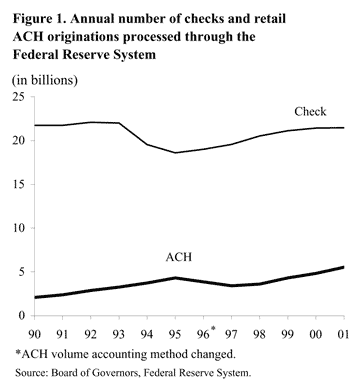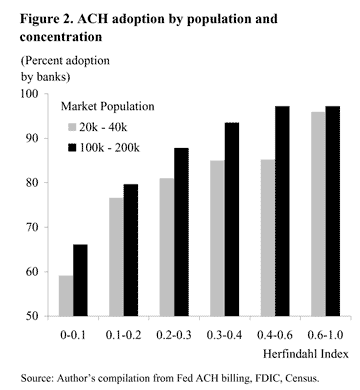In Europe and other industrialized parts of the world, electronic payment mechanisms have largely replaced checks. But in the U.S., paper checks are still very common, accounting for more than 60% of retail payments.
- The evolution of ACH
- Testing for network effects…
- …using market concentration…
- …and using small branch variation
- Conclusions
- Reference
In Europe and other industrialized parts of the world, electronic payment mechanisms have largely replaced checks. But in the U.S., paper checks are still very common, accounting for more than 60% of retail payments.
Why don’t Americans use electronic payments mechanisms more? One possible answer is that U.S. consumers simply prefer checks to the available electronic payments technologies. In that case, there is no efficiency loss from the continued dominance of paper checks.
An alternative answer stems from what economists call “network externalities.” Electronic payments form a network in which consumers and banks exchange payments with other consumers and banks that also accept the technology. Therefore, electronic payments systems are useful only if other entities also use them. So this network externality is a little like the chicken-and-the-egg problem. Specifically, consumers would find it preferable to use electronic payments if many other consumers do, but since a critical mass has not yet adopted the technology, consumers largely do not use it. If network externalities explain why U.S. consumers do not use electronic payments technologies, then there are important implications, insofar as such technologies increase the efficiency of the payments system and lower transaction costs. For instance, this explanation implies that encouraging people and banks to use electronic payments technologies could make others better off, and it also implies that electronic payments products may be underused.
The U.S. has several electronic payment technologies, such as point-of-sale, debit cards, and credit cards. In this Economic Letter I focus on the extent of network externalities for the electronic payment technology known as the automated clearinghouse (ACH). ACH is a technology that was developed by the Federal Reserve and is typically used for small recurring payments between consumers and businesses, such as payroll deposits or mortgage deductions. The results of the analysis suggest that network externalities do play a role in the adoption of ACH.
The Federal Reserve has been involved in ACH technology since the early 1970s, and currently has about over 85% of the market share of ACH transactions; other ACH processors include Visa, Electronic Payments Network, and the American Clearing House. ACH forms a network because both the originating bank and the receiving bank or its designated correspondents must accept ACH to complete the transaction. Presumably, the underlying originating and receiving customers also must be willing to accept ACH for their payments.

Figure 1 shows that, although the number of ACH transactions processed through the Fed has been growing since 1990, it is still much smaller than the number of check transactions. These data are bolstered by estimates for private providers, which process twice as many check transactions as the Fed but only about a third as many ACH transactions.
If there is a fixed cost for consumers and banks to adopt ACH, then when one consumer or bank adopts ACH, other ACH adopters are better off, since they can exchange payments with one more party. Therefore, consumers and banks will be more likely to adopt ACH the more other parties do. Moreover, because ACH usage is technologically intensive, additional users may improve “user friendliness,” which may lower the costs of usage to other consumers. Both effects lead to an externality in which one user’s increased usage of ACH makes other users better off.
To understand the scope of any network externalities for ACH, one must try to predict how much the user’s decision to adopt ACH depends on the number of other users who have adopted ACH. The ideal way to predict this would be to fix two sets of users, A and B, require B to adopt or unadopt ACH, and then observe the extent to which A adopts ACH as a function of B’s decisions. In general, however, ACH adoption decisions are made simultaneously by all individuals in a network, so we cannot observe situations where we choose B’s usage decisions and then observe A’s usage decisions. This makes it challenging to devise methods to infer the magnitudes of the network externalities.
In Gowrisankaran and Stavins (2002), several methods are proposed to test for network externalities in the ACH market. All the methods postulate that the network for transactions is geographically localized. Their simplest idea is to examine whether there is geographic clustering in ACH adoption and usage. The rationale for this test is that, if there are network externalities, then one bank will be more likely to adopt ACH if other banks in its network have adopted it, and with localized transactions, this will yield geographic clusters.
The study finds significant evidence that ACH adoption decisions are clustered. But a pattern of clustering itself need not imply network externalities. For instance, clustering in some parts of the country also may reflect the fact that those areas are more willing to accept technological products. In that case, if users B in an area that is less willing to accept technological products were required to use ACH, this would not make users A in that area more likely to adopt ACH. While the above study uses data that vary over time, which partly address this issue, it is also useful to consider other methods to test for network externalities.
Another method to test for network externalities is to examine ACH adoption decisions as a function of the local market concentration in the banking industry. Consider the highest level of concentration, a monopoly bank: it is not affected by the chicken-and-egg problem inherent in a network because it is not waiting for other banks to adopt ACH before it chooses to adopt it itself. This implies that, all else equal, a network with a monopoly bank is more likely to adopt ACH than is the same network with two or more banks. Given this description of a monopoly bank’s behavior, economists say that it can internalize the network externality. This story may explain why banks in Europe, which has a very concentrated market structure, have been early adopters of electronic payments technologies. More generally, we would expect that networks with higher industry concentration will have more ACH adoption, holding fixed other characteristics of the network, such as the size of the population and of the banks.

To test for concentration effects, Gowrisankaran and Stavins define a market as a metropolitan statistical area (MSA) and use the Herfindahl index measure of industry concentration. In the Herfindahl index, a value of 1 corresponds to a monopoly, 0.5 corresponds to a market with two equal-sized firms, 0.33 to an industry with three equal-sized firms, etc. Figure 2 shows the deposit-weighted fraction of banks adopting ACH across several different markets as a function of the Herfindahl index and population size. The figure shows that, within any population range, more concentrated markets—that is, those with a higher Herfindahl index—are more likely to adopt ACH, which is consistent with the presence of network externalities. Gowrisankaran and Stavins (2002) use more complex econometric methods to recover the magnitudes of the network externalities implied by this pattern, which they find to be quite large. From the figure, one also can see that markets with larger populations are more likely to adopt ACH. The reason for this is that large markets have large firms, and large firms can spread the fixed costs of adoption over more customers.
…and using small branch variation
A third method of testing for network externalities is to try to find a set of banks B whose adoption decisions are made independently of the decisions of banks A in the network but affect the adoption decisions for banks A. While it is difficult in general to find such a set, the fact that banks have multiple branches implicitly creates such a set. To see this, consider a small branch of a large bank that is located in a town isolated from the bank headquarters. The large bank, which must adopt ACH for all of its branches together, is not likely to adopt ACH in response to conditions in the town where its small branch is located. Thus, a local bank A that is based in the town will think of the adoption decisions of the branches of the big bank B as unaffected by its own decisions of whether to adopt ACH.
To implement this test, I follow Gowrisankaran and Stavins (2002) and find a set of small markets that contain exactly one local bank A and one or more branches of nonlocal banks B, where the branches are sufficiently small relative to the size of bank B not to affect bank B’s decisions. The results indicate that if fewer than half the nonlocal banks adopt ACH, the fraction of local banks that also adopt ACH is about 21%; if more than half the nonlocal banks adopt ACH, the fraction of local banks that also adopt ACH rises to 67%. Consistent with the story that a monopoly network is able to internalize the network externality, 58% of local banks that are alone in the market adopt ACH. Gowrisankaran and Stavins (2002) derive formal estimates of the magnitudes of the network externalities from this sample and use them to compute the expected probability of adoption if there were one small bank versus two or more small banks in the market. They find that the network with one small bank will adopt ACH 62% of the time, while the adoption probability will be at most 46% with two small banks, and 43% with three small banks. This again suggests that the magnitude of the network externalities is substantial.
Several different tests provide evidence of substantial network externalities in the market for ACH. This implies that part of the reason for the continued dominance of paper checks is a chicken-and-egg problem, where ACH is not more widely used because of a lack of a critical mass of users. Most new payment technologies are inherently networks. Thus, insofar as new payment technologies can increase the efficiency of the payments system and lower transactions costs, there is a potential concern that network externalities may cause banks and consumers to underadopt many of them. The results suggest that we should consider mechanisms that might facilitate the adoption of new payment technologies by allowing firms to internalize the network externalities.
Gautam Gowrisankaran
Economist
Gowrisankaran, Gautam, and Joanna Stavins. Forthcoming. “Network Externalities and Technology Adoption: Lessons from Electronic Payments.”
Opinions expressed in FRBSF Economic Letter do not necessarily reflect the views of the management of the Federal Reserve Bank of San Francisco or of the Board of Governors of the Federal Reserve System. This publication is edited by Anita Todd and Karen Barnes. Permission to reprint portions of articles or whole articles must be obtained in writing. Please send editorial comments and requests for reprint permission to research.library@sf.frb.org